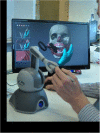The application of virtual reality and augmented reality in Oral & Maxillofacial Surgery
- PMID: 31703708
- PMCID: PMC6839223
- DOI: 10.1186/s12903-019-0937-8
The application of virtual reality and augmented reality in Oral & Maxillofacial Surgery
Abstract
Background: Virtual reality is the science of creating a virtual environment for the assessment of various anatomical regions of the body for the diagnosis, planning and surgical training. Augmented reality is the superimposition of a 3D real environment specific to individual patient onto the surgical filed using semi-transparent glasses to augment the virtual scene.. The aim of this study is to provide an over view of the literature on the application of virtual and augmented reality in oral & maxillofacial surgery.
Methods: We reviewed the literature and the existing database using Ovid MEDLINE search, Cochran Library and PubMed. All the studies in the English literature in the last 10 years, from 2009 to 2019 were included.
Results: We identified 101 articles related the broad application of virtual reality in oral & maxillofacial surgery. These included the following: Eight systematic reviews, 4 expert reviews, 9 case reports, 5 retrospective surveys, 2 historical perspectives, 13 manuscripts on virtual education and training, 5 on haptic technology, 4 on augmented reality, 10 on image fusion, 41 articles on the prediction planning for orthognathic surgery and maxillofacial reconstruction. Dental implantology and orthognathic surgery are the most frequent applications of virtual reality and augmented reality. Virtual planning improved the accuracy of inserting dental implants using either a statistic guidance or dynamic navigation. In orthognathic surgery, prediction planning and intraoperative navigation are the main applications of virtual reality. Virtual reality has been utilised to improve the delivery of education and the quality of training in oral & maxillofacial surgery by creating a virtual environment of the surgical procedure. Haptic feedback provided an additional immersive reality to improve manual dexterity and improve clinical training.
Conclusion: Virtual and augmented reality have contributed to the planning of maxillofacial procedures and surgery training. Few articles highlighted the importance of this technology in improving the quality of patients' care. There are limited prospective randomized studies comparing the impact of virtual reality with the standard methods in delivering oral surgery education.
Keywords: Augment reality; Haptic; Navigation; Oral surgery; Virtual reality.
Conflict of interest statement
The authors declare that they have no competing interests.
Figures


References
-
- Freina L, Ott M. A literature review on immersive virtual reality in education: state of the art and perspectives. 2015.
-
- Bartella AK, Kamal M, Scholl I, Steegmann J, Ketelsen D, Holzle F, et al. Virtual reality in preoperative imaging in maxillofacial surgery: implementation of “the next level”. Br J Oral Maxillofac Surg. 2019;57(7):644–648. - PubMed
-
- Ayoub A, Xiao Y, Khambay B, Siebert P, Hadley D. Toward building a virtual human face. Int J Oral Maxillofac Surg. 2007;36(5):423–428. - PubMed
-
- Naudi K, Benramdan R, Brocklebank L, Khambay B, Ayoub A. The virtual human face - superimposing the simultaneously captured 3D photorealistic skin surface of the face on the untextured skin image of the CBCT scan. Int J Oral Maxillofac. 2013;42(3):393–400. - PubMed
Publication types
MeSH terms
LinkOut - more resources
Full Text Sources
Other Literature Sources

